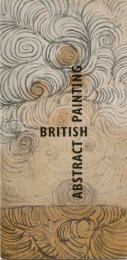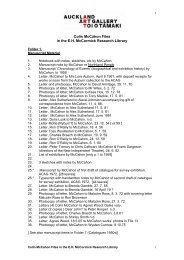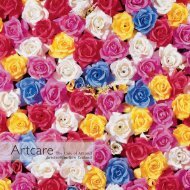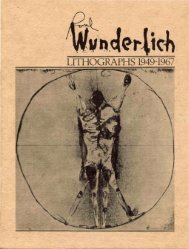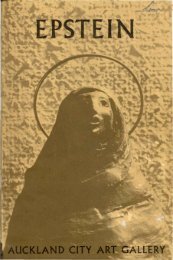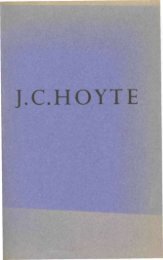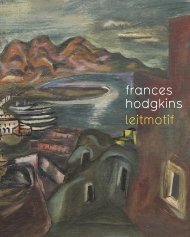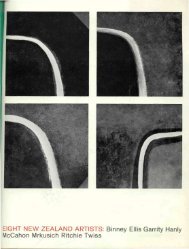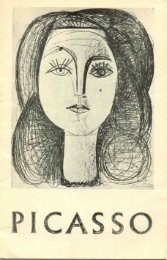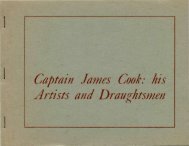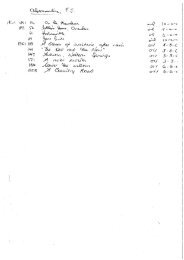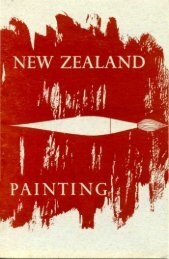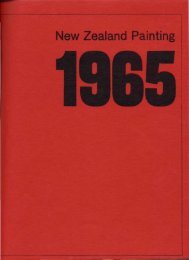Untitled - Auckland Art Gallery
Untitled - Auckland Art Gallery
Untitled - Auckland Art Gallery
You also want an ePaper? Increase the reach of your titles
YUMPU automatically turns print PDFs into web optimized ePapers that Google loves.
as they do towards a true and knowing expression of the landscape."Looking at a lithograph drawing of Perkins' the other day I thought Inoticed another tendency, one which I had been watching for for some time.There was an emphasis on design, and a deliberately formal treatment whichI have not seen in other New Zealand work. The method impressed me, for Ihad come to think that impressionist technique, though it represented onepermanent and fruitful line of march, failed to express the character andsingularity of our natural landscape . . . Our most characteristic natural forms. . . are geometrical and sometimes rigid. And Perkins seemed to me to haveexploited this, and to have given his drawing something of the formal anddelicately selective treatment of a Hokusai or Hiroshige print."Fairburn was not the first to make this comparison. Perkins' Taranaki hadearlier been related to Hokusai, but it has no more or less in common withthat artist than it has with Heaphy's version of Mount Egmont painted nearlyninety years before.Hard light and a particular order of forms characterise New Zealandpainting. Factors other than the painters' physical environment also conditionthe stylistic direction his work will take, but it is not too difficult to see whypaintingin New Zealand should have been wed for so long to the landscape.Colin McCahon indicates something of the dilemma of the New Zealandpainter in his autobiographical essay published in Landfall two years ago:"I saw something logical, orderly and beautiful belonging to the land and notyet to its people." In some ways this comment parallels that Hanly made abouthis paintings in 1963: "There are no people in them, I don't see how I canput them in." Shortly after his return from Europe in 1962, Hanly had inscribeda monoprint from the same series as the painting Welcome to Mount Eden,"Where are all the people Mum?"The discovery of "the people", or more correctly some kind of urban lifeand environment distinguishes much post-1958 painting from previous work.Curiously enough the characteristics which were undoubtedly evolved fromthe landscape and the light seem to have carried over into painting which haslittle relationship to either, as well as into painting with a more figurative bus.From the city the landscape can be viewed objectively, used or discarded, andit no longer offers the only alternative. It might well be that New Zealand'seconomic and social orientation has undergone a similar shift during thesame period.The influence of current international styles on New Zealand painting isparticularly obvious in the first three years of this survey. McCahon's Northlandpanels and Alwyn Lasenby's Horizon paintings are two examples. Overlayingthe primary concern of both painters with the landscape and with light(in McCahon as a symbolic as well as physical element), is a response to whatwas currently happening in West Coast American painting. In the Northlandpanels this was the direct result of McCahon's visit to the area in the sameyear. Paradoxically it seems to have been the application of this kind ofinfluence that allowed New Zealand painting to free itself from an overtconcern with the landscape, in favour of a less subjective and deeper responseto its formal elements. The Northland panels also represent a major break withthe previously small confines of painting here, as well as with a traditionallydiffident involvement with the act of painting. To a lesser extent the samechanges can be detected in the work of Don Peebles and Milan Mrkusichduring the following two years.McCahon's Gate series of 1961 exploits a thoroughly urban source. Althoughthese paintings had been anticipated in a few landscapes of French Bay in1959, they resulted directly from McCahon's move to an inner city suburband have their origin in the rectangular forms of roofs and buildings againstthe harsh <strong>Auckland</strong> sky. In the same year Bryan Dew's savage paintings ofsuburban celebrations, despite their references to earlier painting, suggest afigurative direction which is only now being followed. Hanly's Welcome toMount Eden, Nelson Kenny's Black and white and T. P. Garrity's [con, all



